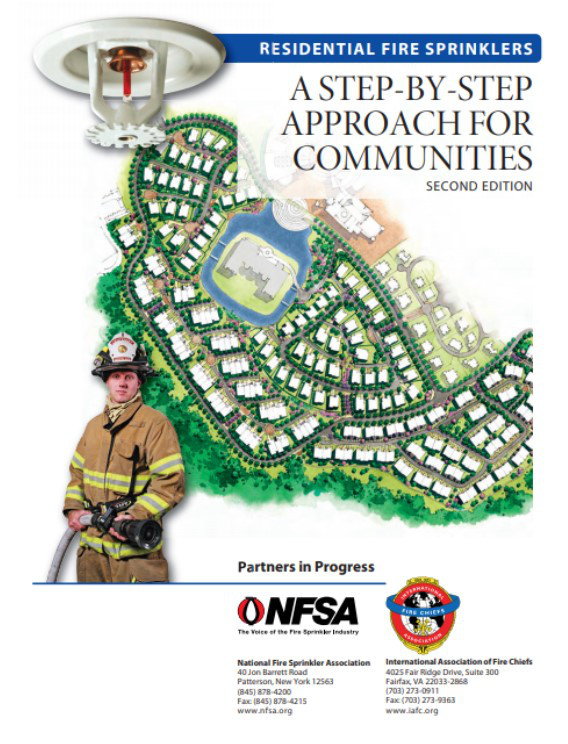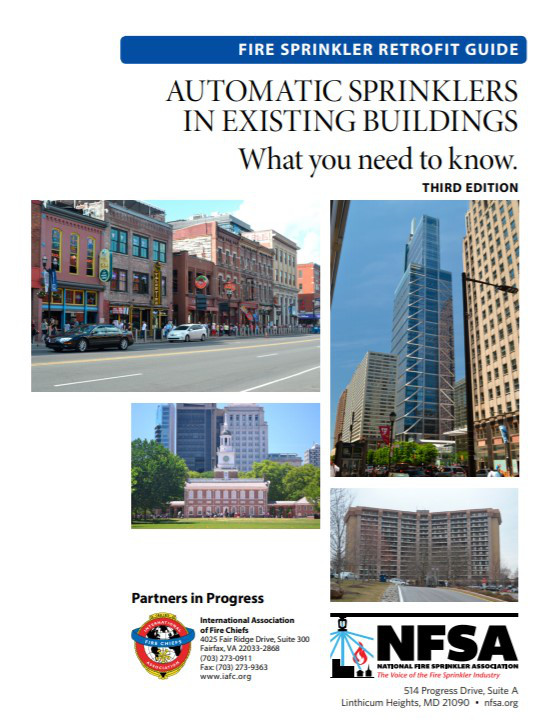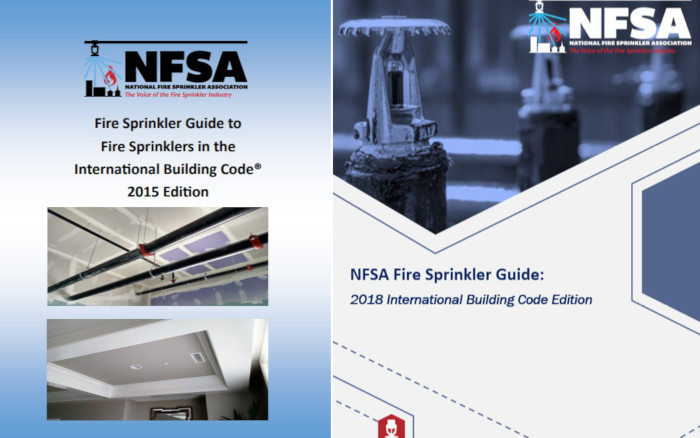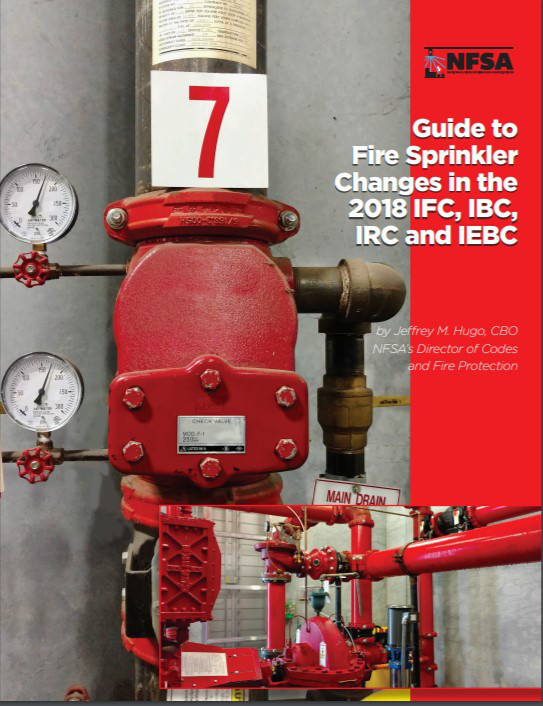NFSA’s Best Fire Protection Guides

Learn more about NFSA’s most-downloaded fire sprinkler guides for contractors, AHJs, and local leaders
When it comes to fire protection, getting the right information to the right constituency is key to enhancing safety. Since 1905, the National Fire Sprinkler Association (NFSA) has never wavered from its mission of protecting lives and property from fire through the widespread acceptance of the fire sprinkler concept. As part of that mission, NFSA offers free fire protection guides that help various stakeholders effectively install sprinklers in their communities.
Whether you are promoting the importance of residential sprinkler system installations or starting a program to retrofit existing buildings, NFSA’s fire protection guides can help. Some resources list all the design advantages that building codes grant to properties that install sprinklers. Others help contractors and authorities having jurisdiction (AHJ) easily get up to speed with changes in new editions of model fire and building codes and standards.
Free access to fire protection guides is available to NFSA members and non-members through our website. Let’s take an in-depth look at some of our most-downloaded resources:
A residential fire sprinkler guide that helps communities adopt home sprinkler requirements
NFSA’s Residential Fire Sprinklers: A Step-by-Step Approach for Communities aims to help communities embrace fire sprinklers—enhancing quality of life by reducing fire risk.
The National Fire Protection Association (NFPA) reports that about 80% of civilian fire deaths happen in the home. And the lightweight, synthetic nature of modern construction materials causes home fires to burn hotter and faster than ever before—leaving people as little as two minutes to escape before it’s too late. When residential fires break out, the same fire protection technology that’s long been common in commercial, industrial, and public buildings can mean the difference between life and death.
But while NFPA model codes and the International Residential Code (IRC) now mandate residential fire sprinklers in all new one- and two-family homes, politics have prevented many communities from adopting the requirements. Across the nation, fire safety professionals and other advocates face an ongoing battle to convince legislators to mandate this life-saving technology in homes. They often face opposition from realtors, home builders, and even some residents who claim that fire sprinklers will push home prices out of reach.
When every second counts, this timeline from the Home Fire Sprinkler Coalition shows how fire sprinklers can mean the difference between life and death:
In its second edition, Residential Fire Sprinklers: A Step-by-Step Approach for Communities offers resources that can help communities take on—and win—the battle to ensure a safer future for residents. The new edition was written by NFSA President Shane Ray, who has a distinguished history in the fire protection community as a firefighter and fire chief, and Vickie Pritchett, NFSA’s Executive Officer, whose public service background has given her invaluable experience navigating local government.
This guide identifies key stakeholders who play a role in adopting life safety systems, giving them the support they need to promote the acceptance of residential fire sprinkler requirements. The guide even directly addresses the homebuilding industry, showing how fire sprinklers offer a marketing advantage and value-added amenity.
Essential stakeholders covered explicitly by the NFSA residential guide include:
- Fire chiefs
- Elected officials
- Building officials
- Fire marshals and inspectors
- City managers and town administrators
- Fire sprinkler contractors
- Homebuilders
This resource helps interested parties determine whether they’re ready to take on the challenge of fighting for residential fire sprinkler requirements in their communities. Once they decide to move forward, it offers advice on mobilizing different parties and conducting the planning and research that increase the chance of success. There are tips for creating successful legislative presentations and strategies to negate the power of opposing arguments.
Once sprinkler requirements are adopted, the guide teaches communities how to provide customer service and support that makes it easy for homeowners to install systems. And finally, in a section called “Never Let Your Guard Down,” the resource helps communities develop strategies to maintain the highest level of fire protection for residents.
Ready to help save lives, property, money, and even potential water resources by advocating for residential fire sprinklers in your community? Download your copy of “Residential Fire Sprinklers: A Step-by-Step Approach for Communities.”
Everything communities need to know about sprinkler retrofit programs
It only took four minutes for an out-of-control fire to engulf the unsprinklered Station nightclub during a concert in 2003. A hundred lives were lost, and more than 200 people were injured.
Building codes only apply to new construction, of course. And thousands of “grandfathered” buildings like The Station nightclub avoid fire sprinkler requirements because they existed before recent versions of building codes were adopted.
But improvements to fire safety regulations in the U.S. often emerge from tragedy. The Station nightclub fire prompted NFPA and the International Code Council to publish fire sprinkler retrofit requirements for similar assembly occupancies.
That same year, NFPA issued a Tentative Interim Amendment (TIA) that required property owners to retrofit nightclubs and similar assembly occupancies that accommodate more than 100 people. The 2018 edition of IFC demands retrofitting existing bars, nightclubs, and restaurants with automatic sprinklers if the fire area where alcohol is consumed holds more than 300 occupants.
Watch this NFPA video to see how quickly the fire spread at The Station nightclub without fire sprinklers. Warning: content may be disturbing to some viewers:
Retrofit regulations identify high-risk occupancies that were built before fire sprinklers were required and mandate retroactive requirements to install these systems within a reasonable timeframe. Communities enforce new mandates as law by adopting model codes that require retrofits or through passing stand-alone ordinances.
Now in its third edition, NFSA’s Fire Sprinkler Retrofit Guide: Automatic Sprinklers in Existing Buildings—What You Need to Know offers a comprehensive collection of best practices aimed at helping fire chiefs, code officials, and other local leaders implement retrofit programs in their communities.
Requirements for retrofitting automatic sprinklers in existing buildings are found in NFPA 1: Fire Code and NFPA 101: Life Safety Code, as well as the International Code Council’s (ICC) building code, (IBC), fire code (IFC), and existing building code (IEBC). New mandates are continually added as unique needs arise.
For instance, a rash of fatal high-rise fires recently prompted ICC code makers to move regulations for retrofitting high-rise buildings into the main body of the upcoming 2021 edition of IFC. IFC’s high-rise retrofit requirements are currently located in Appendix M, which jurisdictions can choose to adopt separately.
NFSA’s retrofit guide:
- Helps interested parties understand what it means to retrofit a building with fire sprinklers. It explains why retrofit programs are needed and details the requirements of NFPA and ICC model codes.
- Provides steps for local leaders to inventory buildings that require retrofits and perform community risk assessments. It includes sample inventory and owner notification forms, as well as case studies to help convince reluctant community members. The guide notes that proper documentation is an essential component of a community retrofit program, stopping property owners from challenging the legal standing of a requirement.
- Offers instruction on retrofitting sprinklers in historic buildings without sacrificing aesthetics or design. And it helps those concerned with retrofit costs weigh alternative plans, such as Engineered Life Safety Systems (also, see NFSA’s new ELSS guide below).
- Digs into the economics behind retrofitting existing buildings with automatic sprinkler systems, reframing the cost as an investment rather than a one-time expenditure. The guide compares the cost of installing sprinklers to the devastating expense of an out-of-control fire. And it helps property owners learn how to take advantage of financial incentives that can make the investment more palatable, such as tax incentives, credits, grants, and insurance discounts.
Ready to learn how to implement a fire sprinkler retrofit program in your community? Download your copy of Fire Sprinkler Retrofit Guide: Automatic Sprinklers in Existing Buildings—What You Need To Know.
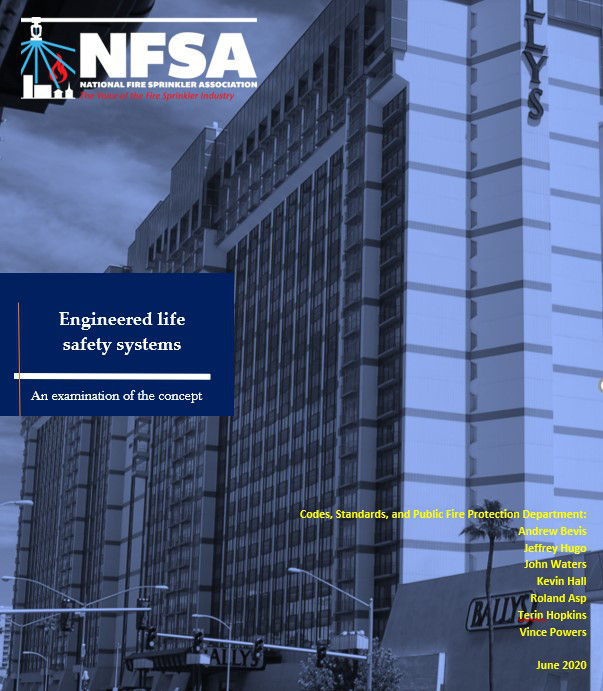
Our new fire protection guide helps authorities weigh ELSS systems as an alternative to sprinkler retrofits
Retrofitting a building with fire sprinklers can be costly for property owners. And when retrofits are required by fire or building codes, fire protection officials often receive questions about whether less-expensive alternatives can be substituted.
In some instances, model codes do allow alternatives that are deemed “equivalent” to the requirements. For example, the 2018 edition of NFPA 101: Life Safety Code requires automatic fire sprinklers in all existing high-rise buildings but does permit the substitution of Engineered Life Safety Systems (ELSS) in ambulatory healthcare, apartment, and business-use occupancies. Such systems must be designed by a registered fire and life safety engineer and approved by the local authority having jurisdiction (AHJ).
ELSS, which is also referred to by other regional names, may include partial automatic sprinkler protection, smoke control systems, smoke alarms, compartmentation strategies, and other approved passive and active systems.
At the end of the day, it’s up to AHJs to determine whether an ELSS can provide a safe alternative to a full sprinkler retrofit. NFSA’s new fire protection guide, Engineered Life Safety Systems: An Examination of the Concept, provides officials with background information and suggested criteria for approving or disapproving alternative systems during sprinkler retrofit programs.
This comprehensive resource details the concept of flashover—the point when a fire becomes untenable and threatens life safety throughout a building—and explains explicitly whether different Engineered Life Safety Systems can prevent it. The guide digs into the difference between passive and active fire protection systems and explains the code requirements, including when alternative methods are allowed.
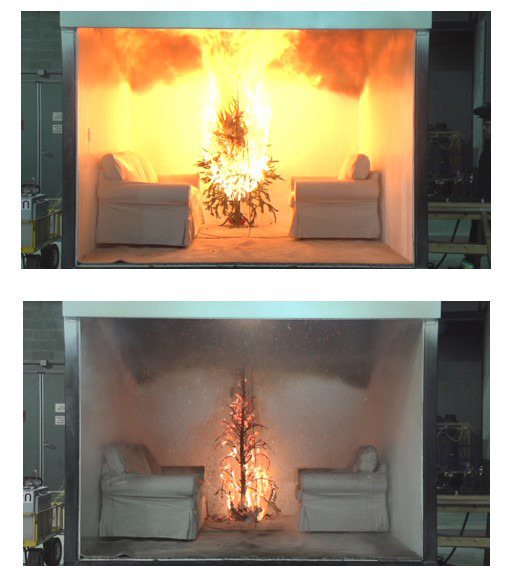
Fire sprinklers in this test successfully prevented flashover in the room of origin by wetting the walls and fuel packages next to the Christmas tree that caught fire. Sprinklers offer the best protection against flashover.
Engineered Life Safety Systems: An Examination of the Concept helps AHJs establish criteria for evaluating alternative systems and explores how the protection they offer compares to fire sprinkler systems. It looks at the cost of ELSS, including long-term expenses like inspection, testing, and maintenance (ITM) that can make fire sprinkler retrofits more cost-effective. The guide points out the potentially devastating cost of an out-of-control fire in buildings without adequate protection. And it notes that the building design advantages offered to properties that install sprinklers by fire and building codes don’t necessarily apply to structures with an ELSS.
Want to learn more about whether ELSS can be a safe alternative to sprinkler retrofits? Download your copy of Engineered Life Safety Systems: An Examination of the Concept here.
Fire sprinkler system design and installation guides: the building design advantages offered by sprinkler installations
Automatic fire sprinklers effectively control or extinguish 96% of the fires that trigger them. So, it comes as no surprise that building codes offer property owners a little more leeway in building design when approved sprinkler systems are installed.
NFSA offers separate fire protection guides that detail every design advantage of approved sprinklers in the 2015 and 2018 editions of the International Building Code (IBC). These resources cover general advantages that apply to every occupancy classification, such as a height increase of 20 feet, or adding a story to buildings with fire sprinklers.
The fire protection guides also spell out specific sprinkler design advantages enjoyed by different occupancy groups, including business, residential, and high-hazard occupancies.
For instance:
- Installing fire sprinklers in assembly occupancies increases the number of combustible decorations that can be used in an auditorium from 10% to as much as 75% in both IBC editions. It also eliminates the need for multiple manual pull fire alarm stations.
- Installing fire sprinklers in residential occupancies reduces the needed fire-resistance rating of partitions between dwelling/sleeping units to a half-hour of protection in both IBC editions. Sprinklers also enable buildings to only have one means of egress from R-2 and R-3 dwelling units. (R-2 occupancies are primarily permanent, such as dormitories or sorority houses. R-3 occupancies are also primarily permanent, like lodging houses with five or fewer guest rooms.)
To learn more about building design advantages associated with automatic fire sprinkler systems, download your copy of Fire Sprinkler Guide to Fire Sprinklers in the International Building Code 2015 Edition and NFSA Fire Sprinkler Guide: 2018 International Building Code Edition.
Stay up-to-date on fire sprinkler changes in 2018 ICC codes
This short fire protection guide, Guide to Fire Sprinklers Changes in the 2018 IFC, IBC, IRC, and IEBC, is a one-stop resource for changes and new code requirements for fire sprinklers in ICC’s recent codes. It compiles articles that help jurisdictions, code officials, architects, engineers, and contractors with adoption, compliance, and enforcement of new code.
The articles are written by NFSA Vice President of Codes, Standards, and Public Fire Protection, Jeffrey M. Hugo, CBO, and reprinted from NFSA’s National Fire Sprinkler Magazine.
The first article summarizes the 21 most significant changes to the 2018 codes, including new requirements for fire pump and fire sprinkler riser rooms, educational occupancies, testing integrated fire protection systems, attic protection in some residential occupancies, self/mini-storage, and more.
Other articles dig deeper into the changes; for example, taking a detailed look at attic protection requirements for properties covered by NFPA 13R: Standard for the Installation of Sprinkler Systems in Low-Rise Residential Occupancies. The guide also explains the 2018 IFC’s new retrofit requirement for fire sprinklers in A-2 occupancies that serve alcohol, which include bars, nightclubs, restaurants, and halls.
Other covered topics include:
- Fire sprinkler requirements for commercial businesses operated out of dwellings and townhouses.
- Design and other benefits provided by fire sprinkler installations in the IRC.
- Changes to the 2018 IFC’s Chapter 32, which significantly impact high-piled storage.
Need to get up-to-date with changes to 2018 ICC codes? Download a Guide to Fire Sprinklers Changes in the 2018 IFC, IBC, IRC, and IEBC.
Fire protection guides help communities benefit from the unmatched protection of fire sprinklers
NFSA’s free, downloadable fire protection guides give people the information they need to deploy fire sprinklers successfully. Whether you are advocating for residential fire sprinkler requirements in your town or need to understand vital changes in the latest model codes quickly, these resources provide the support you need to accomplish your goals.
VIEW ALL NFSA FIRE PROTECTION GUIDES
For over a century, the National Fire Sprinkler Association (NFSA) has served as the voice of the fire sprinkler industry. Our mission: advocating to protect lives and property through the widespread acceptance of the fire sprinkler concept. To join NFSA or learn more about the ways membership can benefit your organization, visit nfsa.org/join.
